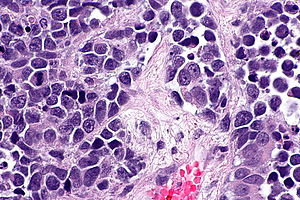Difference between revisions of "Small cell carcinoma of the urinary bladder"
Jump to navigation
Jump to search
(→IHC) |
|||
| Line 45: | Line 45: | ||
Features: | Features: | ||
*See ''[[small cell carcinoma]]''. | *See ''[[small cell carcinoma]]''. | ||
*If mixed histology, ''small cell carcinoma'' component must be majority of tumour; otherwise classified as ''urothelial carcinoma with small cell carcinoma component''. | |||
Note: | Note: | ||
Revision as of 21:18, 17 May 2022
| Small cell carcinoma of the urinary bladder | |
|---|---|
| Diagnosis in short | |
 Small cell carcinoma of the urinary bladder. H&E stain. | |
| LM DDx | small cell carcinoma of the prostate gland, lymphoma (large cell), other small round blue cell tumours |
| Stains | pankeratin +ve, chromogranin +ve, synaptophysin +ve, CD56 +ve |
| Site | urinary bladder |
|
| |
| Symptoms | +/-hematuria |
| Prevalence | very rare |
| Prognosis | poor |
| Clin. DDx | other bladder tumours esp. urothelial carcinoma |
Small cell carcinoma of the urinary bladder, abbreviated SCCUB, is a rare malignant neoplasm of the urinary bladder.
General
- Very rare[1] - less than 1% of bladder cancers in one series.[2]
- Poor prognosis[1] - survival ~ 11 months.[2]
Clinical:
- Hematuria - typical presentation.[2]
Epidemiology:
Microscopic
Features:
- See small cell carcinoma.
- If mixed histology, small cell carcinoma component must be majority of tumour; otherwise classified as urothelial carcinoma with small cell carcinoma component.
Note:
- Usually co-exists with urothelial carcinoma ~60% of cases in one series.[2]
DDx:
- Small cell carcinoma of the prostate gland.
- Lymphoma, large cell.
- Other small round blue cell tumours.
Images
IHC
- Pankeratin +ve,
- Chromogranin +ve.
- Synaptophysin +ve.
- CD56 +ve.
- TTF-1 +ve/-ve.
Sign out
Urinary Bladder Tumour, Transurethral Resection:
- SMALL CELL CARCINOMA, invades muscularis propria, see comment.
-- Please see synoptic report.
Comment:
The tumour consists of cohesive, small blue cells with nuclear moulding and necrosis. There is no definite urothelial differentiation, and no other differentiation to suggest a particular primary site.
The tumour stains as follows:
POSITIVE: CK7 (dot-like moderate, diffuse), chromogranin A (moderate, diffuse), synaptophysin (strong, diffuse), TTF-1 (strong, diffuse).
NEGATIVE: CK20, CD45 (lymphocytes in background), CD20, PSA, p63 (marks benign urothelium).
PROLIFERATION (Ki-67): >90%.
Small cell carcinoma of the urinary bladder is the main consideration, based the anatomical site of the specimen. The findings above should be considered in the context of the imaging and clinical history.
See also
References
- ↑ 1.0 1.1 Koga, F.; Yokoyama, M.; Fukushima, H. (Nov 2013). "Small cell carcinoma of the urinary bladder: a contemporary review with a special focus on bladder-sparing treatments.". Expert Rev Anticancer Ther 13 (11): 1269-79. doi:10.1586/14737140.2013.851605. PMID 24168010.
- ↑ 2.0 2.1 2.2 2.3 2.4 Hou, CP.; Lin, YH.; Chen, CL.; Chang, PL.; Tsui, KH. (2013). "Clinical outcome of primary small cell carcinoma of the urinary bladder.". Onco Targets Ther 6: 1179-85. doi:10.2147/OTT.S49879. PMID 24009428.


